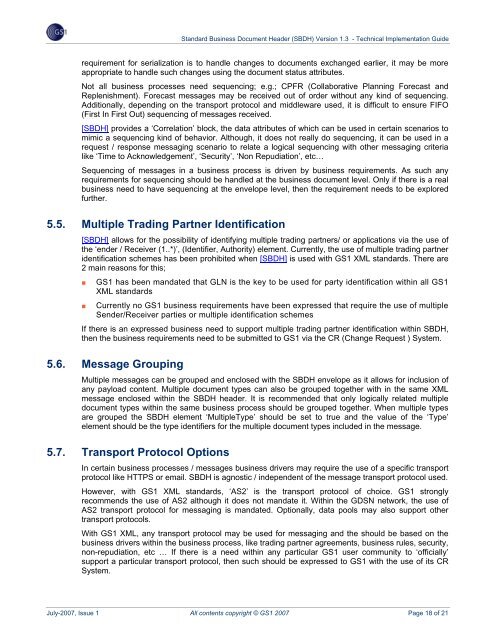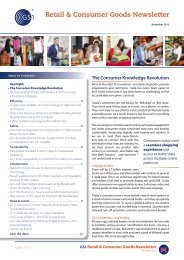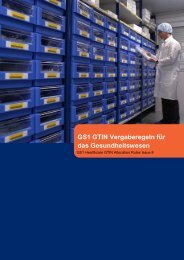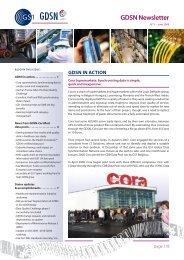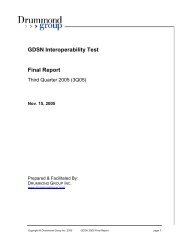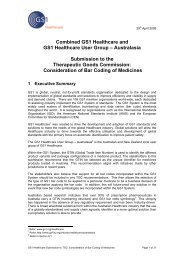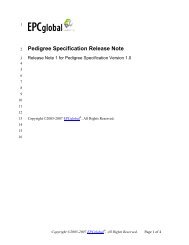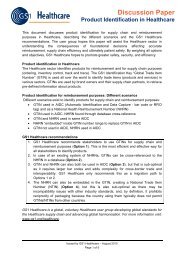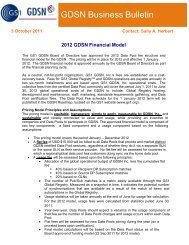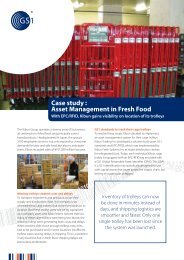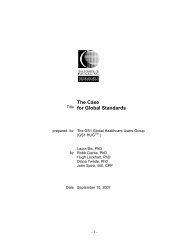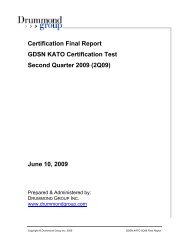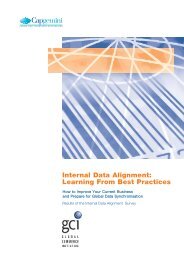SBDH Technical Implementation Guide - GS1
SBDH Technical Implementation Guide - GS1
SBDH Technical Implementation Guide - GS1
Create successful ePaper yourself
Turn your PDF publications into a flip-book with our unique Google optimized e-Paper software.
Standard Business Document Header (<strong>SBDH</strong>) Version 1.3 - <strong>Technical</strong> <strong>Implementation</strong> <strong>Guide</strong><br />
requirement for serialization is to handle changes to documents exchanged earlier, it may be more<br />
appropriate to handle such changes using the document status attributes.<br />
Not all business processes need sequencing; e.g.; CPFR (Collaborative Planning Forecast and<br />
Replenishment). Forecast messages may be received out of order without any kind of sequencing.<br />
Additionally, depending on the transport protocol and middleware used, it is difficult to ensure FIFO<br />
(First In First Out) sequencing of messages received.<br />
[<strong>SBDH</strong>] provides a ‘Correlation’ block, the data attributes of which can be used in certain scenarios to<br />
mimic a sequencing kind of behavior. Although, it does not really do sequencing, it can be used in a<br />
request / response messaging scenario to relate a logical sequencing with other messaging criteria<br />
like ‘Time to Acknowledgement’, ‘Security’, ‘Non Repudiation’, etc…<br />
Sequencing of messages in a business process is driven by business requirements. As such any<br />
requirements for sequencing should be handled at the business document level. Only if there is a real<br />
business need to have sequencing at the envelope level, then the requirement needs to be explored<br />
further.<br />
5.5. Multiple Trading Partner Identification<br />
[<strong>SBDH</strong>] allows for the possibility of identifying multiple trading partners/ or applications via the use of<br />
the ‘ender / Receiver (1..*)’, (Identifier, Authority) element. Currently, the use of multiple trading partner<br />
identification schemes has been prohibited when [<strong>SBDH</strong>] is used with <strong>GS1</strong> XML standards. There are<br />
2 main reasons for this;<br />
■<br />
■<br />
<strong>GS1</strong> has been mandated that GLN is the key to be used for party identification within all <strong>GS1</strong><br />
XML standards<br />
Currently no <strong>GS1</strong> business requirements have been expressed that require the use of multiple<br />
Sender/Receiver parties or multiple identification schemes<br />
If there is an expressed business need to support multiple trading partner identification within <strong>SBDH</strong>,<br />
then the business requirements need to be submitted to <strong>GS1</strong> via the CR (Change Request ) System.<br />
5.6. Message Grouping<br />
Multiple messages can be grouped and enclosed with the <strong>SBDH</strong> envelope as it allows for inclusion of<br />
any payload content. Multiple document types can also be grouped together with in the same XML<br />
message enclosed within the <strong>SBDH</strong> header. It is recommended that only logically related multiple<br />
document types within the same business process should be grouped together. When multiple types<br />
are grouped the <strong>SBDH</strong> element ‘MultipleType’ should be set to true and the value of the ‘Type’<br />
element should be the type identifiers for the multiple document types included in the message.<br />
5.7. Transport Protocol Options<br />
In certain business processes / messages business drivers may require the use of a specific transport<br />
protocol like HTTPS or email. <strong>SBDH</strong> is agnostic / independent of the message transport protocol used.<br />
However, with <strong>GS1</strong> XML standards, ‘AS2’ is the transport protocol of choice. <strong>GS1</strong> strongly<br />
recommends the use of AS2 although it does not mandate it. Within the GDSN network, the use of<br />
AS2 transport protocol for messaging is mandated. Optionally, data pools may also support other<br />
transport protocols.<br />
With <strong>GS1</strong> XML, any transport protocol may be used for messaging and the should be based on the<br />
business drivers within the business process, like trading partner agreements, business rules, security,<br />
non-repudiation, etc … If there is a need within any particular <strong>GS1</strong> user community to ‘officially’<br />
support a particular transport protocol, then such should be expressed to <strong>GS1</strong> with the use of its CR<br />
System.<br />
July-2007, Issue 1 All contents copyright © <strong>GS1</strong> 2007 Page 18 of 21


